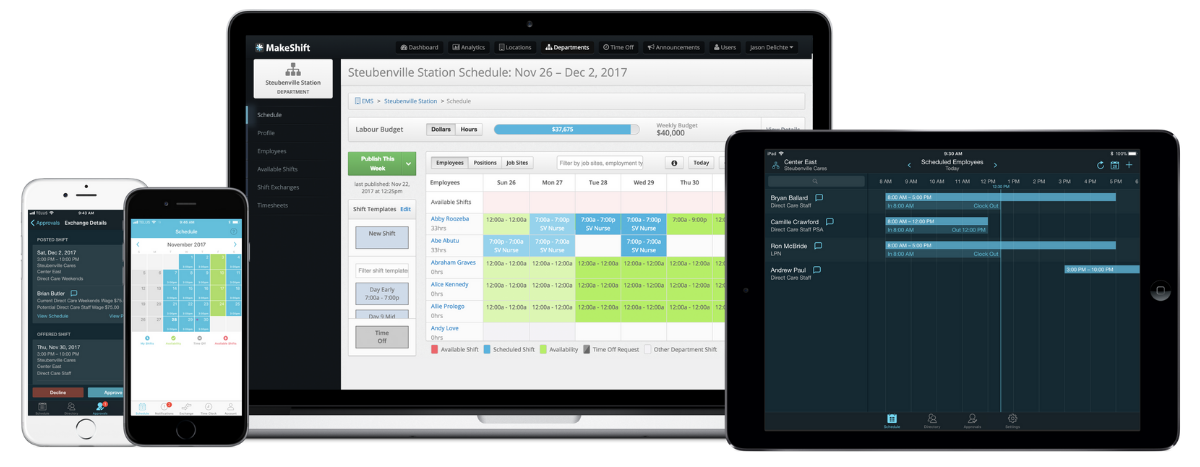Are you filled with dread every quarter when PBJ reporting deadlines roll around?
We get it.
CMS requires a lot of uber-detailed (and accurate) data, not to mention the pressure of knowing your nursing home’s star rating depends on it.
Let’s put aside the dread associated with PBJ reporting for a sec and reframe the idea around it.
CMS created the Five-Star Quality Rating System to help residents, their families, and potential employees easily compare nursing homes and to help identify areas about which they might want to ask questions.
That’s a positive thing.
And if you have low staff turnover and top-notch resident care and facilities, you want the world to know, right?
Sure you do.
So today, let’s talk about how to square away your PBJ reporting by streamlining and automating much of the data collection with tech. Trust us, once you make this move, the dread of PBJ reporting becomes a thing of the past.
- Get a Grip On PBJ Reporting: Common Questions
- What’s In It For You? The Significance of Accurate PBJ Reporting
- 3 Common Challenges Associated with PBJ Reporting
- How Staff Scheduling Software Supports PBJ Reporting
Get a Grip On PBJ Reporting: Common Questions
Before we get into how to nail your PBJ submissions every quarter, let’s run down some frequently asked questions about PBJ reporting.
1. What’s the goal of PBJ reporting?
The goal of PBJ reporting is to ensure transparency and help improve the quality of care in nursing homes by holding facilities accountable for their staffing levels and practices.
CMS uses the collected data to monitor staffing patterns and determine whether facilities meet regulatory requirements, ultimately enhancing resident care.
This data is also used to rate nursing homes. You can see how your facility ranks on the Nursing Home Care Compare website.
2. Which facilities are required to submit PBJ data?
According to CMS, all long-term care and skilled nursing facilities must submit PBJ data, but swing beds don’t.
3. When is PBJ data due & how often should I submit PBJ data?
PBJ data must be submitted quarterly. See the CMS Staffing Data for more detailed info. Missing a deadline can result in severe penalties, including fines and a knock on your CMS star rating.
| Fiscal Quarter | Reporting Period | Due Date |
| Q1 | October 1 — December 31 | February 14 |
| Q2 | January — March 31 | May 15 |
| Q3 | April 1 — June 30 | August 14 |
| Q4 | July 1 — September 30 | November 14 |
4. What format should I put my data in for submission?
You can enter data manually and then submit it to CMS, upload a preformatted XML or CSV file, or submit a combo of manual entry and a file.
5. What data is required?
2 primary data categories should be reported for each employee in one of the 35 designated positions:
- Direct care hours worked – Per employee & contractor/agency personnel per day
- Tenure data – Hire and termination date
✷ See question #8 for info on job codes and descriptions.
6. Which employees count as Direct Care?
Direct care staff, as defined by CMS, are workers who directly interact with residents or manage their care to help them achieve good physical, mental, and emotional health. It's important to include these staff members in your PBJ reporting for accurate data.
Direct care doesn’t include people whose main job is maintaining the facility's building and surroundings, like housekeeping staff.
More specific info about counting hours for Directors of Nursing and other employees who perform various daily duties, like Medical Directors and contract staff, is available here.
7. Which hours count for PBJ submission?
The total hours each staff member, including temp and contract workers, is paid for every day they work in the quarter.
You can count training hours if the staff member is still available for direct care.
Corporate employee hours can be counted if the corporate employee is performing direct care duties.
Direct care hours, such as overtime, PTO, and sick leave, should be excluded.
8. How do I classify my employees by job code titles?
Job codes and descriptions are on pages 14-18 of the PBJ Policy Manual. Remember, you’ll also need to classify your agency and contract workers.
9. How do I report census data?
As of April 2019, census info isn’t required in PBJ reports.
10. How do I report tenure data?
CMS requires each staff member to have an employee record in the PBJ system to track hours and tenure data. The info required for this record includes:
- Unique Employee ID that’s not personally identifiable (it can’t be an employee’s name or social security number)
- Hire Date
- Termination Date
- Pay Type Code
What’s In It For You? The Significance of Accurate PBJ Reporting
PBJ reporting wasn’t invented solely to be a pain in your keister — accurate PBJ reporting empowers everyone.
The idea behind PBJ reporting is three-fold:
- Ensure residents receive quality care.
- Potential residents and their families can access accurate data when choosing a long-term care facility.
- To make nursing homes great places to live and work.
Today’s nursing homes are experiencing a much-needed culture shift that prioritizes overall resident well-being and a positive work environment. The data collected for PBJ reporting supports this shift.
3 Common Challenges Associated with PBJ Reporting
While much good comes from accurate PBJ reporting, managing all the required data can be cumbersome, especially when you use manual processes.
1. Manual Data Entry = Errors
Manual data entry is prone to errors like typos, transpositions, and omissions. CMS looks for 70 different errors on PBJ submissions. If you receive a fatal error, you must correct it and resubmit your entire report.
Not to be a downer, but you should know the probability of human errors with manual data entry can be as high as 40%.

Staff members will record data differently, leading to inconsistencies in reporting or categorizing hours, which can be a mess.
2. Old-school Record-Keeping is a Time Drain
Traditional record-keeping methods, like paper timesheets or spreadsheets, can soak up time like a black hole swallows up light.
Do you think old-school manual data entry is serving you just fine? Think again.
- 83% of workers said they spend 1-3 hours fixing manual data errors daily.
- 76% of employees spend 1-3 hours a day simply moving data from one place to another when automation isn’t used.
Let’s put that in perspective — If an employee spends just 1 hr/day on manual data management, that’s 20 hours a month and roughly 230 hours a year on a task that could be automated.
3. Accurately Tracking & Reporting Staff Hours
Accurately tracking and reporting staff working hours is critical to PBJ reporting (and your facility’s success).
Let’s hone in on 3 specific nursing home staff tracking headaches:
1. Part-time & floating Staff — Tracking hours for part-time and floating staff is tricky because their schedules may vary widely from week to week. This variability can lead to inaccuracies in reported hours.
2. Agency & contract staff — Nursing homes often use agency or contract staff to fill staffing gaps. Accurately tracking and reporting their hours can be difficult, particularly if they work irregular shifts or at multiple facilities.
But you’ve got to figure out how to track these staff hours accurately.
In January 2022, CMS announced that weekend staffing and turnover data would be included in calculating the Five-Star Staffing Rating.
3. Overtime & shift swaps — Managing overtime hours and shift swaps can complicate PBJ reporting. If not accurately recorded, they can lead to discrepancies in your reported data.
How Staff Scheduling Software Supports PBJ Reporting
Many nursing homes still opt for manual management of timesheets, staff scheduling, and PBJ reporting. Often because it’s what they’ve always done, and they don’t want to rock the boat.
Change is rarely easy.
But with today’s nursing home staff shortages, you can’t afford to resist change.
On the up side, most of your staff actually want more tech at work.

Research shows that employees who feel they've got supportive tech at work are 158% more engaged and 61% more likely to stay beyond 3 years. That bodes well for your facility AND your CMS Five-Star Rating.
Staff scheduling software can revolutionize and optimize workflows. It can also make PBJ reporting infinitely easier and more accurate.
Regarding PBJ reporting, staff scheduling software offers specific benefits that we’ll unpack below.
1. Automation of data collection
Staff scheduling software can automate the data collection process, drastically reducing the likelihood of human error and saving hours of effort.
Our Solution: Ditch manual timesheets for MakeShift’s automated time-tracking
MakeShift's time-tracking feature allows for precise recording of staff hours, which is crucial for accurate PBJ reporting. We use geofencing so employees can clock in & out on their phones.

MakeShift’s time tracking can track employees' regular, overtime, and holiday hours.
You can easily monitor staff hours and generate reports detailing the total hours worked by each staff member, broken down by job category.
MakeShift can then automatically compile staffing data into a CSV file for CMS submission, reducing the administrative burden on nursing home staff.

This data is essential for complying with CMS staffing requirements and ensuring accurate PBJ submissions.
Bonus benefits of MakeShift’s time-tracking
- Photos on time punches prevent "buddy punching”
- More accurate timesheets
- Payroll integration
- Easily compare daily shift schedule to clock-ins
2. Real-time staff schedule tracking
Real-time tracking ensures staff hours get recorded accurately. This feature is handy for managing part-time, floating, and agency staff, whose hours may vary from week to week.
Your employees are humans with lives outside work — there will always be unexpected movement in your staff schedules because life happens.
Scheduling software tracks and records any schedule adjustments to ensure accuracy on PBJ submissions.
Our Solution: Let MakeShift keep track of real-time schedule tweaks
MakeShift provides live updates on staffing levels, helping ensure you always meet CMS nurse-to-patient ratios. This real-time data can also be used to make immediate adjustments to staffing as needed.

You can easily send out available shift notices and approve requests to keep employees happy and your nursing home running smoothly. MakeShift automatically adjusts schedules. You’ll never need to record schedule changes manually again.
Bonus benefits of MakeShift’s automated schedule tracking
- Workforce forecasting with an AI-powered platform
- Simple shift planning
- The app makes schedule access easy for everyone
3. Compliance features
Staff scheduling software often includes features designed to help facilities maintain compliance with CMS regulations.
For example, the software can generate automated alerts if staffing levels fall below required thresholds, allowing administrators to address understaffing promptly.
Some software can also remind you of important deadlines, such as the submission of PBJ reports to CMS. These reminders help ensure that reports are submitted accurately and on time, avoiding penalties for late or incomplete submissions.
Our Solution: Let MakeShift stay on top of compliance
MakeShift can handle the heavy lifting of monitoring and maintaining CMS compliance in 4 ways:
1. Accurate staffing data — It allows for precise tracking of staff hours, roles, and credentials. This is crucial for PBJ reporting, which requires detailed records of staff hours and types of staff working at any given time.
2. Consistency in reporting — With automated tools, the data collected is consistent and reliable, reducing the risk of human error that can occur with manual entries.
This ensures only accurate information is reported to CMS, helping you avoid penalties for non-compliance.
3. Efficient staff management — Makeshift can optimize staffing by ensuring that the correct number of staff with the appropriate skills are working at the right times.
This helps meet the CMS staffing requirements, which are critical for compliance and quality of care.
4. Timely submission — Automated scheduling systems can generate reports needed for CMS compliance more quickly and accurately than manual methods. This helps in meeting submission deadlines, which is a critical aspect of compliance.
Bonus benefits of MakeShift’s staff scheduling software:
- HIPPA compliant software
- Easily accommodates rotating schedules
- Higher retention rates through optimal staff scheduling
Streamline PBJ Reporting and Staff Scheduling In 1 Swoop
We know PBJ reporting can be daunting. And yet, your CMS rating depends on timely, accurate submissions quarter after quarter.
But when you adopt staff scheduling software, you’ll streamline your PBJ reporting and staff scheduling in a single bound.
Ready to see how MakeShift can do both for you? Schedule your free demo today.








